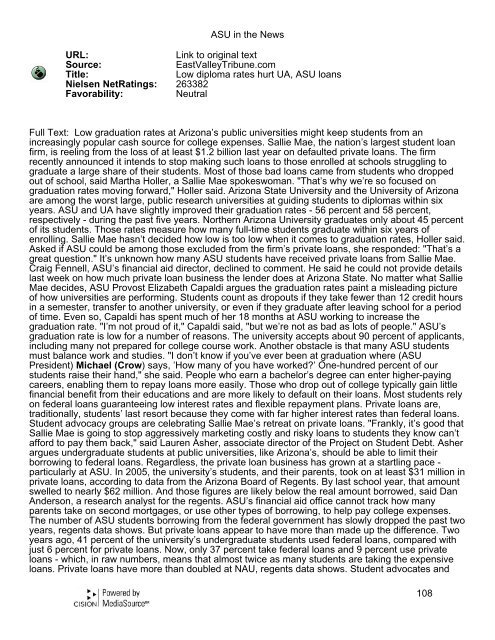asu in the news 02-06-08 to - ASU News - Arizona State University
asu in the news 02-06-08 to - ASU News - Arizona State University
asu in the news 02-06-08 to - ASU News - Arizona State University
- No tags were found...
Create successful ePaper yourself
Turn your PDF publications into a flip-book with our unique Google optimized e-Paper software.
<strong>ASU</strong> <strong>in</strong> <strong>the</strong> <strong>News</strong><br />
URL: L<strong>in</strong>k <strong>to</strong> orig<strong>in</strong>al text<br />
Source: EastValleyTribune.com<br />
Title: Low diploma rates hurt UA, <strong>ASU</strong> loans<br />
Nielsen NetRat<strong>in</strong>gs: 263382<br />
Favorability: Neutral<br />
Full Text: Low graduation rates at <strong>Arizona</strong>’s public universities might keep students from an<br />
<strong>in</strong>creas<strong>in</strong>gly popular cash source for college expenses. Sallie Mae, <strong>the</strong> nation’s largest student loan<br />
firm, is reel<strong>in</strong>g from <strong>the</strong> loss of at least $1.2 billion last year on defaulted private loans. The firm<br />
recently announced it <strong>in</strong>tends <strong>to</strong> s<strong>to</strong>p mak<strong>in</strong>g such loans <strong>to</strong> those enrolled at schools struggl<strong>in</strong>g <strong>to</strong><br />
graduate a large share of <strong>the</strong>ir students. Most of those bad loans came from students who dropped<br />
out of school, said Martha Holler, a Sallie Mae spokeswoman. "That’s why we’re so focused on<br />
graduation rates mov<strong>in</strong>g forward," Holler said. <strong>Arizona</strong> <strong>State</strong> <strong>University</strong> and <strong>the</strong> <strong>University</strong> of <strong>Arizona</strong><br />
are among <strong>the</strong> worst large, public research universities at guid<strong>in</strong>g students <strong>to</strong> diplomas with<strong>in</strong> six<br />
years. <strong>ASU</strong> and UA have slightly improved <strong>the</strong>ir graduation rates - 56 percent and 58 percent,<br />
respectively - dur<strong>in</strong>g <strong>the</strong> past five years. Nor<strong>the</strong>rn <strong>Arizona</strong> <strong>University</strong> graduates only about 45 percent<br />
of its students. Those rates me<strong>asu</strong>re how many full-time students graduate with<strong>in</strong> six years of<br />
enroll<strong>in</strong>g. Sallie Mae hasn’t decided how low is <strong>to</strong>o low when it comes <strong>to</strong> graduation rates, Holler said.<br />
Asked if <strong>ASU</strong> could be among those excluded from <strong>the</strong> firm’s private loans, she responded: "That’s a<br />
great question." It’s unknown how many <strong>ASU</strong> students have received private loans from Sallie Mae.<br />
Craig Fennell, <strong>ASU</strong>’s f<strong>in</strong>ancial aid direc<strong>to</strong>r, decl<strong>in</strong>ed <strong>to</strong> comment. He said he could not provide details<br />
last week on how much private loan bus<strong>in</strong>ess <strong>the</strong> lender does at <strong>Arizona</strong> <strong>State</strong>. No matter what Sallie<br />
Mae decides, <strong>ASU</strong> Provost Elizabeth Capaldi argues <strong>the</strong> graduation rates pa<strong>in</strong>t a mislead<strong>in</strong>g picture<br />
of how universities are perform<strong>in</strong>g. Students count as dropouts if <strong>the</strong>y take fewer than 12 credit hours<br />
<strong>in</strong> a semester, transfer <strong>to</strong> ano<strong>the</strong>r university, or even if <strong>the</strong>y graduate after leav<strong>in</strong>g school for a period<br />
of time. Even so, Capaldi has spent much of her 18 months at <strong>ASU</strong> work<strong>in</strong>g <strong>to</strong> <strong>in</strong>crease <strong>the</strong><br />
graduation rate. "I’m not proud of it," Capaldi said, "but we’re not as bad as lots of people." <strong>ASU</strong>’s<br />
graduation rate is low for a number of reasons. The university accepts about 90 percent of applicants,<br />
<strong>in</strong>clud<strong>in</strong>g many not prepared for college course work. Ano<strong>the</strong>r obstacle is that many <strong>ASU</strong> students<br />
must balance work and studies. "I don’t know if you’ve ever been at graduation where (<strong>ASU</strong><br />
President) Michael (Crow) says, ’How many of you have worked?’ One-hundred percent of our<br />
students raise <strong>the</strong>ir hand," she said. People who earn a bachelor’s degree can enter higher-pay<strong>in</strong>g<br />
careers, enabl<strong>in</strong>g <strong>the</strong>m <strong>to</strong> repay loans more easily. Those who drop out of college typically ga<strong>in</strong> little<br />
f<strong>in</strong>ancial benefit from <strong>the</strong>ir educations and are more likely <strong>to</strong> default on <strong>the</strong>ir loans. Most students rely<br />
on federal loans guarantee<strong>in</strong>g low <strong>in</strong>terest rates and flexible repayment plans. Private loans are,<br />
traditionally, students’ last resort because <strong>the</strong>y come with far higher <strong>in</strong>terest rates than federal loans.<br />
Student advocacy groups are celebrat<strong>in</strong>g Sallie Mae’s retreat on private loans. "Frankly, it’s good that<br />
Sallie Mae is go<strong>in</strong>g <strong>to</strong> s<strong>to</strong>p aggressively market<strong>in</strong>g costly and risky loans <strong>to</strong> students <strong>the</strong>y know can’t<br />
afford <strong>to</strong> pay <strong>the</strong>m back," said Lauren Asher, associate direc<strong>to</strong>r of <strong>the</strong> Project on Student Debt. Asher<br />
argues undergraduate students at public universities, like <strong>Arizona</strong>’s, should be able <strong>to</strong> limit <strong>the</strong>ir<br />
borrow<strong>in</strong>g <strong>to</strong> federal loans. Regardless, <strong>the</strong> private loan bus<strong>in</strong>ess has grown at a startl<strong>in</strong>g pace -<br />
particularly at <strong>ASU</strong>. In 2005, <strong>the</strong> university’s students, and <strong>the</strong>ir parents, <strong>to</strong>ok on at least $31 million <strong>in</strong><br />
private loans, accord<strong>in</strong>g <strong>to</strong> data from <strong>the</strong> <strong>Arizona</strong> Board of Regents. By last school year, that amount<br />
swelled <strong>to</strong> nearly $62 million. And those figures are likely below <strong>the</strong> real amount borrowed, said Dan<br />
Anderson, a research analyst for <strong>the</strong> regents. <strong>ASU</strong>’s f<strong>in</strong>ancial aid office cannot track how many<br />
parents take on second mortgages, or use o<strong>the</strong>r types of borrow<strong>in</strong>g, <strong>to</strong> help pay college expenses.<br />
The number of <strong>ASU</strong> students borrow<strong>in</strong>g from <strong>the</strong> federal government has slowly dropped <strong>the</strong> past two<br />
years, regents data shows. But private loans appear <strong>to</strong> have more than made up <strong>the</strong> difference. Two<br />
years ago, 41 percent of <strong>the</strong> university’s undergraduate students used federal loans, compared with<br />
just 6 percent for private loans. Now, only 37 percent take federal loans and 9 percent use private<br />
loans - which, <strong>in</strong> raw numbers, means that almost twice as many students are tak<strong>in</strong>g <strong>the</strong> expensive<br />
loans. Private loans have more than doubled at NAU, regents data shows. Student advocates and<br />
1<strong>08</strong>


